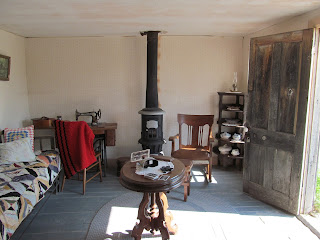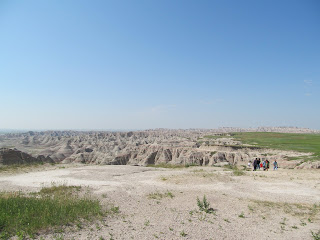We stayed the night at Wall, SD, where it is famous for the
Wall Drugstore. That was kind of a disappointment as it’s renovated and just
another tourist souvenir store. We stopped in a saloon for our afternoon beer.
The next day we did a loop through the Badlands. They are an
amazing land formation. We first stopped at the Brown homesteading cabin. (Somehow we missed the missile silo
site). The Brown family homesteaded here 160 acres in 1909. The house was into
the hill with buffalo grass sod bricks one of the construction materials along
with Cottonwood logs. The floor was hard clay and they had added a lot of
artifacts, a few originals from the Brown family and the rest ones that
sodbusters like them might have owned. An old Singer treadle sewing machine,
like the one Grandma Mitchell taught me to sew on, was there. A wooden deserted
claim shack was added on for the living room later. The cave and chicken house
were dug into the bank. The cave served as a refrigerator in summer and a place
that food and milk would not freeze in winter.
Usually a homestead had a plow and maybe one or two other
pieces of machinery, that they shared with each other. Prairie dogs (we stopped
earlier at a prairie dog town and
fed them peanuts! Very cute!) , a rodent related to ground
squirrels, must have made Mrs. Brown’s gardening efforts difficult.
 This area was one of the last to be homesteaded as western
SD was set aside as Indian reservation. The Homestead Act required that 5 acres
be plowed into crops. Another requirement was living on the land for 18 months
and then paying $.50/acre, or $80, for a patent on the homestead. This the
Brown’s did. Most, including this family, had a hard time surviving poverty. It
has been determined that 160 acres like this would only sustain eight cows.
This area was one of the last to be homesteaded as western
SD was set aside as Indian reservation. The Homestead Act required that 5 acres
be plowed into crops. Another requirement was living on the land for 18 months
and then paying $.50/acre, or $80, for a patent on the homestead. This the
Brown’s did. Most, including this family, had a hard time surviving poverty. It
has been determined that 160 acres like this would only sustain eight cows.
Edgar Brown was born in Iowa in
1854 and died there at the Prairie Homestead in 1920. His wife moved later to
California with a daughter and died in 1943. Another farmer rented it from the
son, Charles, until 1949 when he moved away. Very interesting site to visit and it gave you an
appreciation for the difficulties of life here.
We drove next through the Badlands, a very formidable and weird
landscape, caused by water and wind erosion. Not very hospitable for farming,
which is why they probably gave it to the Indians to live in! Until they took
even that!!
While we were viewing one of these
sites











No comments:
Post a Comment